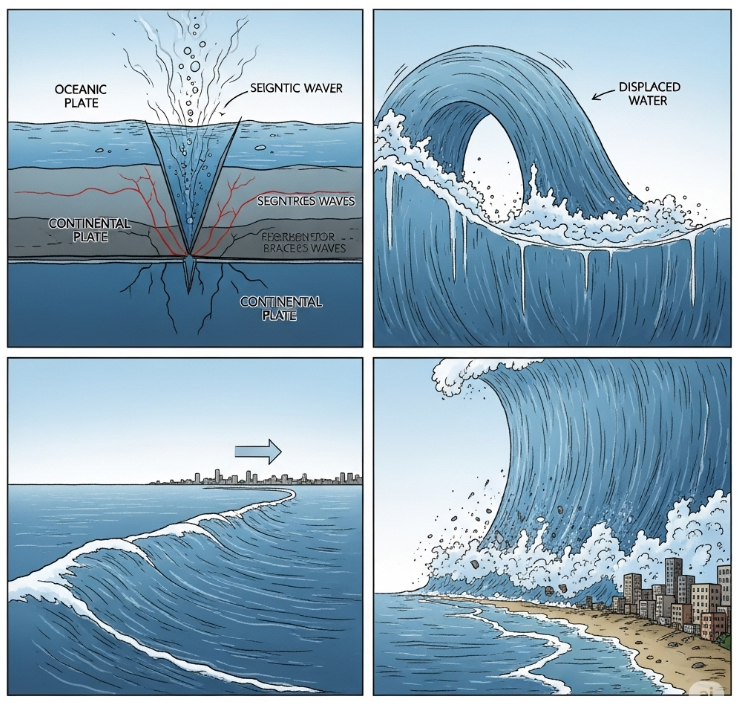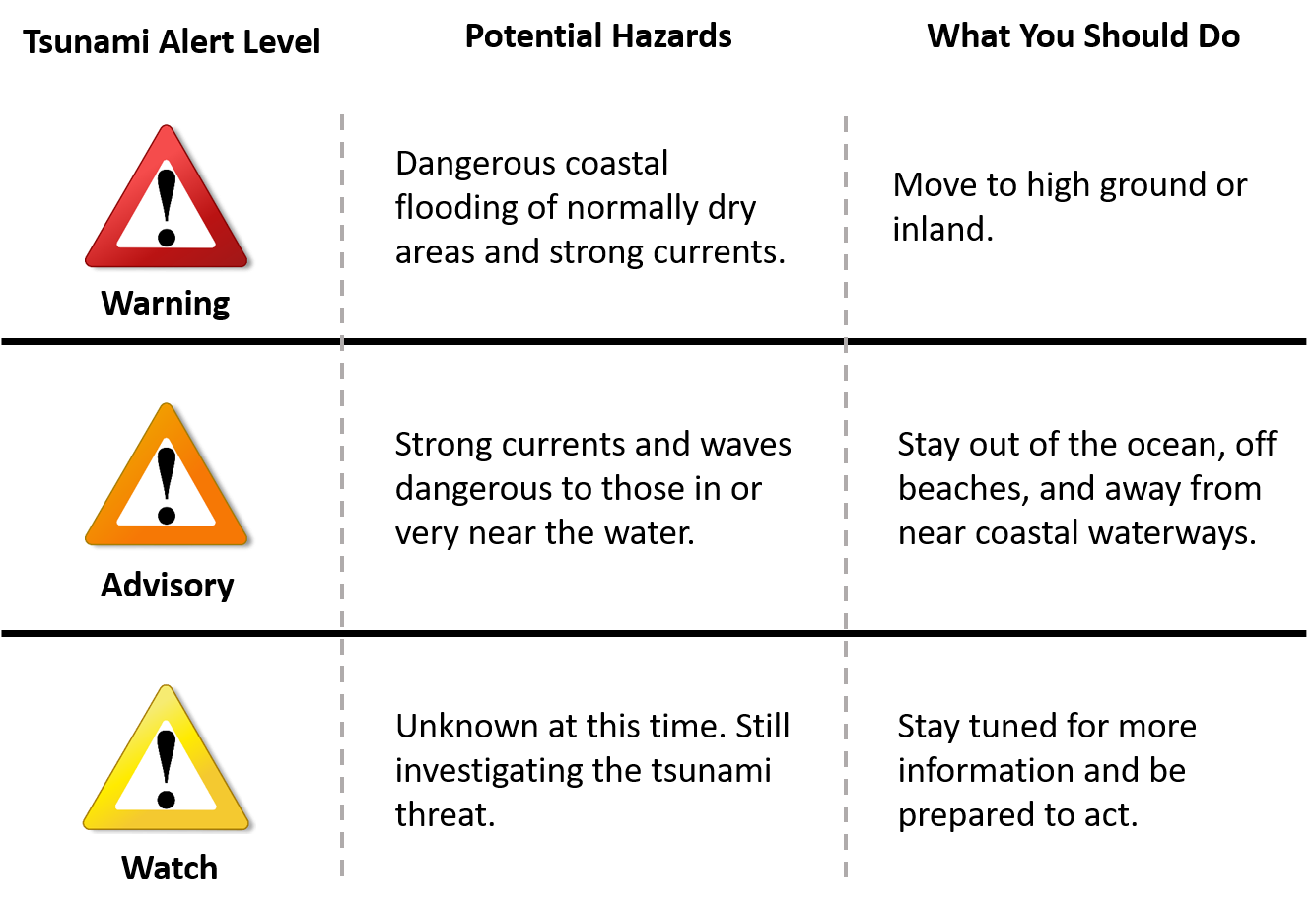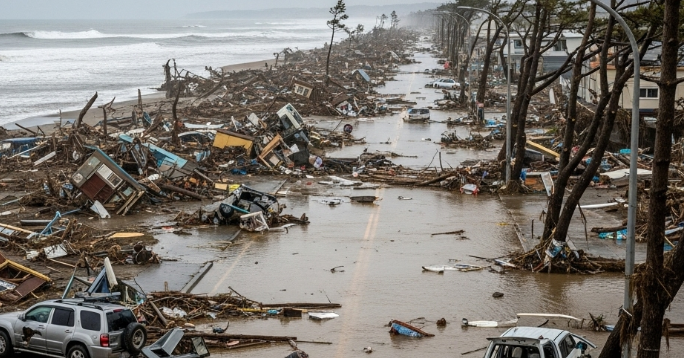How an Earthquake Triggers a Tsunami and What You Should Do
On July 29, 2025, a colossal M8.8 earthquake ruptured the seafloor off Russia's Kamchatka Peninsula. It was an event so powerful that it sent shockwaves through the planet and propelled a massive tsunami across the entire Pacific Ocean.
Within minutes, a cascade of alerts was issued. For millions of people in Japan, Hawaii, and along the U.S. West Coast, the words "Tsunami Warning" flashed across their screens, turning a distant geological event into an immediate, personal threat. The incident was a stark reminder of the powerful connection between the ground beneath our feet and the ocean at our shores. It also raised urgent questions for anyone living near a coastline: How does an earthquake actually cause a tsunami? What do the different alerts mean? And most importantly, what should I do to keep my family safe? This is your guide to understanding the threat and taking action.
From a Rumble Deep Below to a Wave on the Horizon
Many people know that large earthquakes can cause tsunamis, but the mechanics behind them are both fascinating and terrifying. It isn’t the shaking of the ground itself that creates the wave; the key is the vertical movement of the seafloor.
Most of the world’s most powerful earthquakes occur in what are called "subduction zones". These are areas where one of Earth's massive tectonic plates dives, or "subducts," beneath another. For decades, even centuries, the edges of these plates can get stuck or "locked" together. As they remain locked, immense stress builds up, causing the overriding plate to slowly bulge upwards like a bent ruler.
When the stress finally becomes too much, the fault ruptures. The edge of the overriding plate violently snaps back, lurching upward by several feet in a matter of seconds. This sudden uplift acts like a gigantic paddle, thrusting the entire column of water above it towards the surface. This is the birth of a tsunami. It's this vertical displacement of the seafloor, not the horizontal shaking, that so efficiently generates these waves.


A Real-World Tsunami Warning: How the U.S. Responded
The July 2025 Kamchatka earthquake provided a live-action test of the U.S. Tsunami Warning System. The response wasn't a single, blanket alarm, but a carefully tiered series of alerts tailored to the specific threat level for different regions. Understanding tsunami alerts levels is critical.
Tsunami Warning: This is the highest level of alert. It means a dangerous, inundating tsunami is imminent or expected, and immediate evacuation is required. During the Kamchatka event, a full Tsunami Warning was issued for parts of Alaska and, most critically, for the entire state of Hawaii. Sirens blared as authorities ordered evacuations from all low-lying coastal areas. The threat was real: waves reaching 5.7 feet were recorded in Maui.
Tsunami Advisory: This is a step down, but still serious. It means a tsunami is expected that could produce strong currents or waves, dangerous to anyone in or near the water. Widespread flooding isn't expected, but you should stay away from beaches, harbors, and marinas. The U.S. West Coast, including California, Oregon, and Washington, was placed under a Tsunami Advisory. While these states were spared major flooding, they experienced the dangerous currents the advisory warned of. Crescent City, California, saw waves 3.7 feet high.
Tsunami Watch: This is the earliest alert level. It means a distant earthquake has occurred that could generate a tsunami, and you should stay alert and be prepared to take action. Some sections of the U.S. West Coast were initially under a Tsunami Watch. As data from offshore buoys and tide gauges confirmed tsunami activity, select regions were upgraded to a Tsunami Advisory, while others had the alert canceled.
Tsunami Information Statement: Relax—An earthquake has occurred, but there is no threat or it was very far away and the threat has not been determined. In most cases, there is no threat of a destructive tsunami.
This event showed that a tsunami warning isn't just a possibility; it's a reality that requires an immediate and informed response.


Your Essential Tsunami Survival Guide: Before, During, and After
You cannot stop a force of nature like a tsunami, but you can absolutely prepare for it. Your safety depends on the work you do long before a wave ever forms and how you react when a warning is issued.
Phase 1: Prepare Before the Wave Arrives
This is the most important phase. The work you do now is what will protect you when seconds count.
Know Your Zone: Find out if your home, work, or school is in a tsunami hazard zone. Many coastal communities have evacuation maps online. Identify your evacuation routes and practice walking or driving them. Your goal is to get to a location at least one mile inland or 100 feet above sea level.
Make a Plan: How will your family communicate if you are separated? Designate an out-of-state friend or relative as your central contact point, since long-distance calls are often easier to make after a disaster. Decide on a safe place to meet if you can't go home.
Build a "Go Bag": Every household needs an emergency kit you can grab without thinking. It should include:
Water and non-perishable food for several days
A battery-powered or hand-crank radio for official updates
A flashlight and extra batteries
A first-aid kit
A multi-day supply of essential medications and glasses
Sturdy shoes and protective clothing, as you may be walking over debris
Cash and copies of important documents (IDs, insurance policies)
Know the Natural Warning Signs: Sometimes, the first warning won't come from an official source, but from the Earth itself. Teach everyone in your family to recognize these signs:
Strong, long-lasting earthquake: If you're at the coast and feel shaking so strong it's hard to stand, that earthquake is your warning.
A loud ocean roar: A sound like a train or a jet engine coming from the ocean.
Unusual ocean behavior: The water may suddenly and dramatically recede, exposing the ocean floor, or it may rise suddenly like a fast-moving tide.
If you experience any of these signs, evacuate immediately. Do not wait for an official warning.
Phase 2: Survive During the Event
When a tsunami is approaching, your actions must be swift and decisive.
If you feel an earthquake, Drop, Cover, and Hold On first. Once the shaking stops, evacuate to high ground immediately.
If you receive an official Tsunami Warning, evacuate immediately. Follow the instructions of local officials and use your practiced evacuation routes.
If you are caught in the water, grab onto anything that floats and hold on.
What NOT to Do
NEVER go to the shore to watch a tsunami. If you can see the wave, you are too close to escape.
DO NOT assume the first wave is the last or the largest. A tsunami is a series of waves, and the danger can last for hours. The second or third wave could be bigger.
DO NOT wait for an official warning if you experience natural signs. The earthquake itself is your signal to move.
Phase 3: Stay Safe After the Tsunami Passes
The danger isn't over just because the waves have stopped.
Wait for the "All Clear" from local officials before returning to evacuated areas. Dangerous currents can persist for hours or even days.
Avoid floodwaters, which can be contaminated and hide dangerous debris or downed power lines.
Be careful inside buildings, checking for gas leaks or electrical damage. Use battery-powered flashlights, not candles.
Ensure food and water are safe. Throw away any food that contacted floodwater. Listen to public health officials about drinking water safety.
Before you start cleaning up, take photos of the damage to your property for insurance purposes.


The Most Important Takeaway about Tsunami Warning
The 2025 Kamchatka earthquake was a powerful demonstration of nature's force, but it also proved the value of preparation. In places like Hawaii and Japan, years of public education and drills meant that when the warning came, people knew what to do.
You cannot control when an earthquake will strike, but you can control how you prepare. By knowing your risk, making a plan, and being ready to act on any warning, whether from an official alert or the shaking of the ground, you give yourself and your family the best possible chance of staying safe.